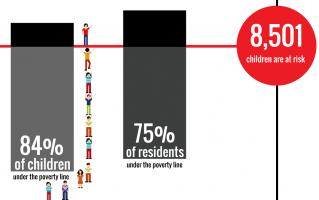
A new report by the Association for Civil Rights in Israel (ACRI) provides a concerning overview of the human rights situation for Palestinians in Jerusalem. The report – East Jerusalem: Facts and Figures 2015 – paints a picture of persistent neglect and increasing violence.
These figures are well known to the authorities: Palestinians constitute 37% of the population of Jerusalem. 75% of them live under the poverty line. 33% of Palestinian students in Jerusalem do not finish Year 12. Only 64% of households are properly connected to the city’s water network. Only 7% of the postal workers operating in Jerusalem provide services to the Palestinian neighborhoods. 39% of houses are built without permits. There is no urban development, and the city will not even fix broken roads in neighborhoods beyond the separation barrier. During the summer of 2014, there were fierce confrontations with the police, following which at least 5 children lost their sight in one eye due to the use of sponge-tipped bullets. The youngest of these children was 6 years old.
The report – East Jerusalem: Facts and Figures 2015 – provides a comprehensive and updated insight into the severe violations of human rights suffered by Palestinians residents of Jerusalem. The facts in this report are based on the official figures of the Jerusalem Municipality, Israel Police, the Central Bureau of Statistics, and other official agencies.
To access the full report, click here.
To access an infographic with more facts, click here.
|
Facts and Figures: East Jerusalem 2015 • Number of residents: There are 300,200 Palestinian residents in Jerusalem, who constitute 36.8% of the city’s population.
• Separation Barrier: More than ¼ of residents reside in Jerusalem neighborhoods that are disconnected from the rest of the city due to the construction of a separation barrier. These residents suffer from a severe lack of basic services and infrastructure.
• Residency status: Palestinians in Jerusalem are not citizens, but rather permanent residents; in 2014, the residency status of 107 Palestinian residents of Jerusalem was revoked.
• Living below the poverty line: 75.4% of all Palestinian residents, 83.9% of Palestinian children.
• Welfare services: 37% of those receiving welfare services in Jerusalem are Palestinians, but only 22% of the social workers are allocated to them.
• Schools: Only 41% of Palestinian children are enrolled in official municipal high schools. There is a shortage of 1,000 classrooms in the official municipal education system; 194 official classrooms were added between the years 2009-2014, and an additional 211 are in planning.
• Inadequate classrooms: 43% of the classrooms in the official municipal system are defined as inadequate classrooms.
• School dropout rate: 26% in 11th grade, 33% in 12th grade; the national average stands at a few percent.
• Planning and building: Approximately 20,000 houses were built without a permit; recently, a large outline plan was approved for the neighborhood of Arav al-Swahara.
• House demolitions: In 2014, 98 structures were demolished and 208 residents have been uprooted from their homes; Israel has also renewed its policy of punitive demolitions for the houses of terrorists.
• Water: Only 64% of households are officially connected to the water infrastructure of Hagihon Corporation – Jerusalem’s water and wastewater company.
• Sewage: There is a shortage of approximately 30 kilometers of sewage pipes; throughout 2015, Hagihon plans to lay an additional 8.2 kilometers.
• Street names: Since 2011, names were given to hundreds of streets that had stood nameless for decades, but the streets of entire neighborhoods still remain unnamed.
• Postal services: Only 7% of the postal workers operating in Jerusalem provide services to the Palestinian neighborhoods; there are 8 post offices in East Jerusalem, compared with 40 in the city’s West; during peak hours at the central post office on Saleh e-Din St., the waiting time often stands at more than two hours.
• Infant healthcare stations: In the Palestinian neighborhoods, there are only 6 “Tipat Halav” (infant healthcare) stations operated by the Ministry of Health, and a seventh station in Kafr Aqab that is operated by a private contractor. In the Israeli neighborhoods, the Ministry of Health operates 26 Tipat Halav stations, 3 of which are designated also for the Palestinian population.
• The neighborhoods behind the Separation Barrier: Between a quarter to a third of East Jerusalem residents live in neighborhoods that have been cut off from the city by the Separation Barrier, and they are forced to pass through checkpoints on a daily basis. The residents of these areas suffer from severe neglect and a tremendous shortage of services and infrastructure; their persistent appeals to the authorities receive no response.
|







